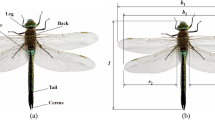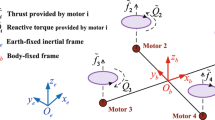Abstract
The robust aeroelastic control of a three-degrees-of-freedom (3DOF) linear and non-linear wing-flap system under sliding mode control (SMC) and operation in supersonic flight speeds is presented. Open- and closed-loop aeroelastic responses to blast and sonic-boom excitation in the wing-flap system with uncertainty, as well as flutter analysis, are investigated along with the implementation of a Sliding Mode Observer (SMO). The effectiveness of control in reducing the amplitude of oscillation and preventing flutter instability is demonstrated.
Similar content being viewed by others
Abbreviations
- a :
-
Non-dimensional elastic axis position measured from the mid-chord, positive aft
- B :
-
Ratio of the nonlinear to the linear pitching stiffness
- M, H, K :
-
Mass, damping, and stiffness matrices
- b :
-
Half-chord length
- e :
-
Non-dimensional leading-edge flap position measured from the mid-chord, positive aft
- F a , F c :
-
Aerodynamic and control load vectors
- h, α, β :
-
Plunging, pitching, and flap displacements
- I α , I β :
-
Mass moment of inertia per unit span of the wing-flap system about the elastic axis (EA) and of the flap about the flap axis (FA) of rotation, respectively
- k h , k α , k β :
-
Stiffness parameters in plunging, torsional stiffness of the wing and flap about the EA
- L, M ea , H β :
-
Total lift per span, aerodynamic moment, and hinge moment
- l α , m ea , h β :
-
Non-dimensional aerodynamic lift, moment, and torque
- m :
-
Airfoil mass per unit span
- M F , M f :
-
Flutter speed and flight speed
- ρ ∞ :
-
undisturbed density
- U∞, V:
-
free stream speed and its nondimensional counterpart
- r α , r β :
-
Non-dimensional radii of gyration of the wingflap system about EA
- S α , x α :
-
Static unbalance about EA and its nondimensional counterpart
- S β , x β :
-
Static unbalance about FA and its nondimensional counterpart
- t, τ :
-
Time variable and its nondimensional counterpart
- κ :
-
Polytropic gas coefficient
References
L. Librescu and P. Marzocca, “Advances in the linear/non-linear control of aeroelastic structural systems,” Acta Mechanica, vol. 178, no. 3–4, pp. 147–186. 2005.
V. Mukhopadhyay, “Flutter suppression control law design and testing for the active flexible wing,” Journal of Aircraft, vol. 32, pp. 45–51, 1995.
V. Mukhopadhyay, “Benchmark active control technology,” Journal of Guidance, Control, and Dynamics, part I, vol. 23, pp. 913–960, part II, vol. 23, pp. 1093–1139, part III, vol. 24, pp. 146–192, 2000–2001.
S. Na, L. Librescu, P. Marzocca, C. Rubillo, G. Yoon, and K. Bong, “Robust aeroelastic control of two-dimensional supersonic flapped wing systems,” Acta Mechanica, vol. 192, no. 1–4, pp. 37–47, 2007.
S. Na, L. Librescu, P. Marzocca, G. Yoon, and C. Rubillo, “Robust aeroelastic control of 2-d supersonic flapped lifting surfaces,” Proc. of the 47th AIAA/ASME/ASCE/ASC Structures, Structural Dynamics, and Materials Conference, AIAA-2006-1836, May 2006.
P. Marzocca, L. Librescu, S. Na, C. Rubillo, and C. Yoon, “Nonlinear aeroelastic response and control of supersonic flapped 2-D lifting surfaces,” Proc. of the AIAA/ASME/ASCE/AHS/ASC Structures, Structural Dynamics, and Materials Conf., May 2006.
H. Ashley and G. Zartarian, “Piston theory — a new aerodynamic tool for the aeroelastician,” Journal of the Aerospace Sciences, vol. 23, no. 10, pp. 1109–1118, 1956.
P. Marzocca, L. Librescu, and G. Chiocchia, “Aeroelastic response of 2-d lifting surface to gust and arbitrary explosive loading signatures,” International Journal of Impact Engineering, vol. 25, pp. 41–65, 2001.
L. Librescu, S. Na, P. Marzocca, C. Chung, and M. Kwak, “Active aeroelastic control of 2-d wing-flap systems operating in an incompressible flowfield and impacted by a blast pulse,” Journal of Sound and Vibration, vol. 283, no. 3–5, pp. 685–706, 2005.
G. C. Goodwin, S. Graebe, and M. Salgado, Control System Design, Prentice-Hall, Inc., 2001.
C. Edwards, S. K. Spurgeon, Sliding Mode Control — Theory and Applications, Taylor and Francis, London, UK, 1998.
M. Allen, F. Bernelli-Zazzera, and R. Scattolini, “Sliding mode control of a large flexible space structure,” Control Engineering Practice, vol. 8, pp. 861–871, 2000.
M. J. Balas, “Feedback control of flexible systems,” IEEE Trans. on Automatic Control, vol. 23, no. 4, pp. 673–679, 1978.
D. J. Inman, “Active modal control for smart structures,” Philosophical Transactions: Mathematical, Physical & Engineering Sciences, pp. 205–219, 2000.
R. H. Scanlan and R. Rosenbam, Introduction to the Study of Aircraft Vibration and Flutter, The Macmillan Co., 1951.
M. Kim, Nonlinear Control and Robust Observer Design for Marine Vehicles, Ph.D. Thesis, VPI&SU, 2000.
Author information
Authors and Affiliations
Corresponding author
Additional information
Recommended by Editorial Board member Hyo-Choong Bang under the direction of Editor Jae Weon Choi. The authors would like to acknowledge the late Professor Liviu Librescu of Virginia Tech, who help, guide and support through the years have made this research possible. He will be remembered and deeply missed. S. Na also acknowledges the financial support from KOSEF (No. 2009-0063170).
Bok-Hee Lee received his B.S. degree in Mechanical Engineering from Korea University in 2006, and he is now a graduate student of Korea University. His research interests include vibration control of aerospace wing and composite turbine blade.
Jeong-hwan Choo received his B.S. degree in Mechanical Engineering from Dongguk University in 2008, and he is now a graduate student of Korea University. His research interests include active vibration control and aeroelasticity.
Sung-soo Na graduated from Korea University with his B.S. and M.S. degree both in Mechanical Engineering. He earned his Ph.D degree in 1997 at the Dept. of Engineering Science and Mechanics at VPI in USA. He has been a Professor at the Dept. of Mechanical Enigneering in Korea University in Seoul, Korea since 2001. His research interest lies in Vibration Control, Protein Dynamics, Protein Mechanics and BioNano Mechanics
Pier Marzocca received his Ph.D. degree in Aeronautical and Aerospace Engineering in 2001 from Politecnico di Torino in Italy. He is currently an Associate Professor in the Department of Mechanical and Aeronautical Engineering, Clarkson University, USA. He is senior member of AIAA, ASME, SAE, Chair of the SAE Unmanned Aircraft System Committee and serves as an Associate Editor of Journal of Thermal Stresses and Journal of Aerospace Engineering. His current research interests include unsteady aerodynamics, flow and aeroelastic control, aircraft and wind turbine technologies.
Rights and permissions
About this article
Cite this article
Lee, BH., Choo, Jh., Na, S. et al. Sliding mode robust control of supersonic three degrees-of-freedom airfoils. Int. J. Control Autom. Syst. 8, 279–288 (2010). https://doi.org/10.1007/s12555-010-0214-8
Received:
Revised:
Accepted:
Published:
Issue Date:
DOI: https://doi.org/10.1007/s12555-010-0214-8




